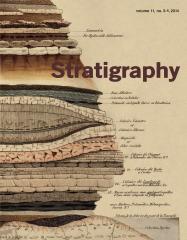Eocene stratigraphy of the Wadi Al-Hitan World Heritage Site and adjacent areas (Fayum, Egypt)Chris King, Charlie Underwood, and Etienne Steurbaut.StratigraphyVolume 11, No. 3-4pp. 185-234

ABSTRACT: The middle and late Eocene stratigraphy and depositional environments of the Wadi Al-Hitan area, Egypt,are described in detail for the first time. Complex facies relationships have been resolved by detailed logging of key sectionsover a 300 sq. km area and by biostratigraphic analysis. Mid and outer neritic marls and argillaceous limestones of the lowerGehannam Formation are overlain proximally by a major coastal sand body complex, the Birket Qarun Formation, which(as preserved) was deposited almost entirely on the lower shoreface. The sands of the Birket Qarun Formation progradedprogressively northwards in four phases, with individual sand bodies separated by transgressive wedges of inner to mid-neriticsilts and clays (the upper Gehannam Formation and the newly named Garet El-Naqb Formation). The final phase ofprogradation was terminated by the transgressive lower Qasr El-Sagha Formation.Calcareous nannofossil Zone NP17 (late Bartonian) is represented in the lowest Gehannam Formation. The Dictyococciteserbae nannofossil acme, previously recorded from Italy and ODP sites, has been identified at a higher level within the lowerGehannam Formation. Its start (in early NP18) is suggested as an excellent criterion to define the base of the Priabonian.Zone NP18 is highly condensed; sedimentation rates increased dramatically in early NP19/20 with the shift to predominantlyclastic sedimentation. The Birket Qarun Formation is entirely within Zone NP19/20 (Priabonian).Seven depositional sequences are tentatively differentiated. Previous sedimentologic and paleogeographic interpretationsare discussed; there is no evidence for ‘bay’ or otherwise restricted environments within this area, and previously proposedepisodes of emersion are also discounted. Levels with relatively abundant marine mammals mainly reflect episodes of reducedclastic sedimentation, but are partly biased by differing surface exposure of successive intervals. There is no evidencethat these levels represent whale ‘calving grounds’, or that marine mammals were unusually concentrated in this area in life.